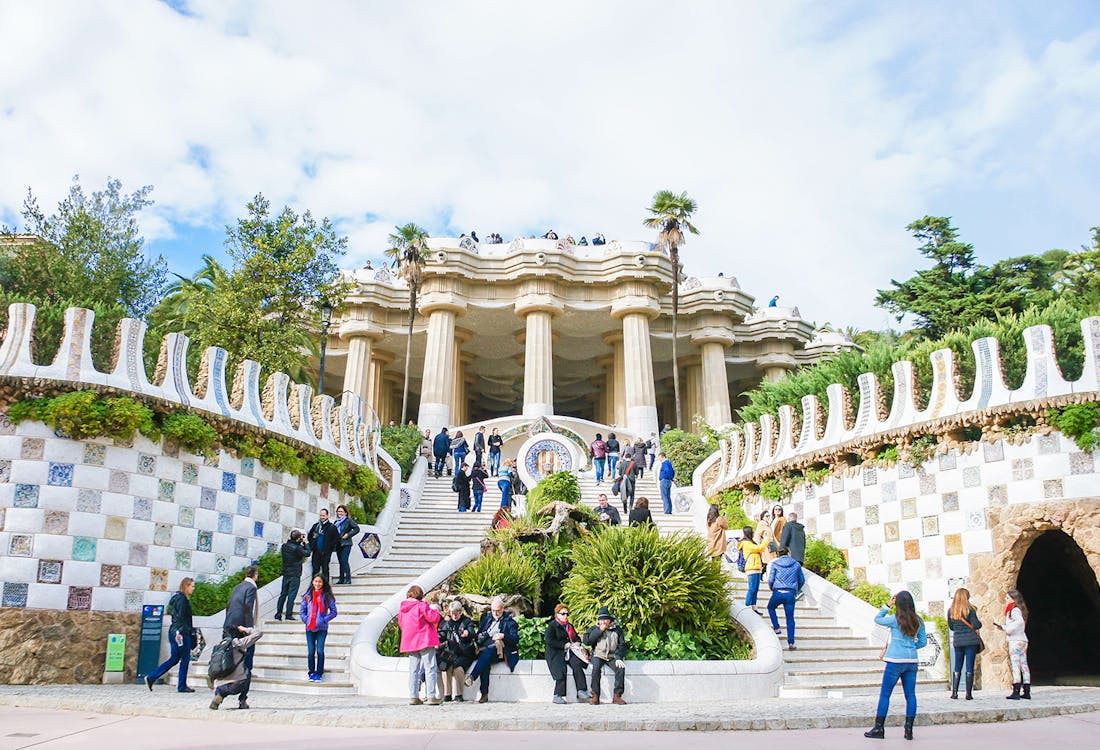From luxury housing to a public park: The story of Park Güell
Park Güell is one of Barcelona's most unique and colorful landmarks, designed by Antoni Gaudí, the genius behind the Sagrada Familia. However, what many visitors don’t realize is that this whimsical park was originally planned as an upscale residential community. Today, Park Güell is a UNESCO World Heritage Site and a must-visit attraction, but its history is a tale of ambition, failure, and transformation.
The origins: Gaudí’s ambitious project
At the start of the 20th century, Barcelona’s wealthy elite was looking for new housing concepts. Eusebi Güell, an industrialist and one of Gaudí’s biggest patrons, wanted to create a luxurious residential estate inspired by English garden cities. He commissioned Gaudí to design a gated community with 60 exclusive villas, stunning green spaces, and modern amenities.
Gaudí’s architectural vision & inspirations
Gaudí’s Modernist (Catalan Art Nouveau) style is evident throughout Park Güell, where he masterfully blended architecture with nature. His designs incorporate organic shapes, religious symbolism, and natural materials, reflecting his belief that architecture should be an extension of the natural world.
Key influences on Park Güell:
- British garden cities: Inspired by the urban planning movement in England, Güell envisioned a self-contained community surrounded by green spaces.
- Catalan nationalism: The park features elements of Catalan identity, such as references to local legends and folklore.
- Nature-inspired forms: Gaudí’s use of curving pathways, tree-like columns, and mosaic-covered structures mimics the forms found in nature.

The role of Eusebi Güell: Patron and visionary
Eusebi Güell was more than just a financier; he was a visionary who believed in Gaudí’s ability to redefine urban living. As a successful textile magnate and businessman, Güell used his wealth to fund ambitious cultural projects that blended art, architecture, and urban planning.
His relationship with Gaudí spanned decades, leading to several collaborations, including Palau Güell and the crypt at Colònia Güell. Park Güell was meant to be his most ambitious project, but despite its commercial failure, it remains one of the most celebrated architectural sites in the world.
Why the project failed
Despite Gaudí’s visionary designs, the project struggled to attract buyers. The location was too far from the city center, and the idea of living in such a futuristic setting didn’t appeal to Barcelona’s wealthy families at the time. By 1914, construction stopped, and only two houses had been built—one of which Gaudí lived in himself (now the Gaudí House Museum).
A second life as a public park
After Güell’s death in 1918, his heirs sold the land to the city of Barcelona. In 1926, Park Güell was officially opened to the public, allowing everyone to enjoy Gaudí’s artistic and architectural genius.
Controversies & modern challenges
Like many world-famous landmarks, Park Güell faces challenges in balancing tourism and preservation.
- Over-tourism: The park limits visitors through timed entries and ticketed access to the monumental zone.
- Preservation efforts: Ongoing restoration projects maintain Gaudí’s original designs while preventing damage from heavy foot traffic.
- Local vs. tourist use: While Barcelona residents once used the park freely, ticketing has made it more of a tourist attraction, sparking debates about accessibility for locals.
Park Güell today: A must-visit attraction
In 1984, Park Güell was declared a UNESCO World Heritage Site, securing its place as a cultural treasure. Today, it’s one of Barcelona’s top tourist destinations, attracting millions of visitors every year.
Top things to see in Park Güell:
- The Dragon Fountain (El Drac): This colorful mosaic lizard is one of Barcelona’s most photographed spots. It’s actually a hidden rainwater drainage system!
- The Hypostyle Hall: A grand columned space that was originally intended as a marketplace.
- The Serpentine Bench: A winding, brightly colored bench designed with Gaudí’s signature trencadís (broken tile mosaic) technique.
- The Austria Gardens: Once intended for homes, this area is now a peaceful garden with panoramic city views.
Park Güell in popular culture
Park Güell’s surreal beauty has made it a sought-after backdrop in films, music videos, and literature. It was prominently featured in Woody Allen’s Vicky Cristina Barcelona (2008), where Scarlett Johansson and Javier Bardem’s characters stroll through its vibrant mosaic-covered benches. The park also appears in Bollywood’s Zindagi Na Milegi Dobara (2011), adding to its global cinematic appeal. Music videos, such as Kylie Minogue’s Slow (2003), have also used Park Güell’s whimsical architecture as a stunning visual element. Additionally, the park is frequently showcased in travel documentaries and remains one of the most Instagrammed locations in Barcelona, rivaling the Sagrada Família.
Hidden symbols & lesser-known spots
- Religious references: Originally, a chapel was planned for the park, and the cross-topped towers reflect Gaudí’s deep Christian faith.
- Natural symbolism: Columns resemble trees, pathways curve like rivers, and structures blend into the landscape as if they were part of the earth itself.
- Less-visited areas: The Porter’s Lodge and Laundry Room Portico showcase Gaudí’s attention to detail but are often overlooked by tourists.
Recommended tickets to the Park Güell
Frequently asked questions
Park Güell was initially designed as a luxury housing project inspired by English garden cities but was later converted into a public park after the project failed commercially.
The park’s blend of nature, architecture, and Catalan Modernism sets it apart, featuring colorful mosaics, organic structures, and innovative designs by Gaudí.
In 1984, UNESCO recognized Park Güell as part of Gaudí’s works due to its artistic and architectural significance.
While much of the park is free, the central monumental zone requires a ticket due to conservation efforts.
Yes, Gaudí lived in one of the two completed houses in the park from 1906 to 1925. The house is now a museum showcasing his personal belongings and furniture.
Arrive early to avoid crowds, book tickets in advance, and explore both the monumental zone and the lesser-known areas for a complete experience.


